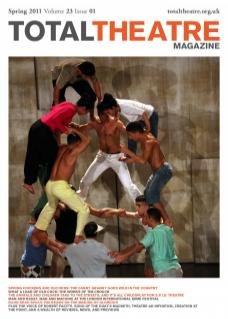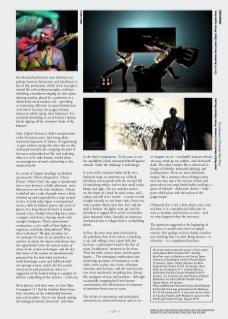What is it to be human? What is our journey as a human being? What distinguishes us from the rest of the animal kingdom, and how do we place ourselves in relation to the rest of the natural world? What distinguishes us from the objects we interact with, and from the machines that we have built to serve us?
These mighty philosophical questions are at the heart of a number of shows presented at the London International Mime Festival 2011 – the specific qualities of ‘human nature’ tested when the human encounters ‘otherness’ (animate or inanimate; beast or machine).
In Les Corbeaux (The Crows), a collaboration between choreographer/performer/ scenographer Josef Nadj and freeform jazz multi-instrumentalist Akosh Szelevenyi, we are taken on a journey that explores the heart of ‘crowness’ – revealing, along the way, that the human form can embrace ‘otherness’ and somehow enter the spirit both of other living creatures (crows) and of inanimate materials (paint, paper, brush).
Taking the form of an improvisation between mover and music-maker, Les Corbeaux is a work that, although it has a set framework or structure, will inevitably be substantially different from show to show. It is not the easiest or most accessible of Nadj’s work – and it perhaps compares unfavourably with his collaboration with Miquel Barcelo, Paso Doble, which shares a similar exploration of the man/ beast/material matter triad – and is similarly a kind of ‘live action’ artwork (3D sculpture in Paso Doble; 2D painting in Les Corbeaux).
For this reviewer, the show (as seen on this occasion) didn’t work as a complete piece. There were far too many sections of musical noodling and ritual ‘actions’ (with metal tubing and sand and the like) that seemed like downtime, and which I felt I’d seen/heard a thousand times before. (A mis-spent youth going to London Musicians’ Collective gigs and performance ‘happenings’ in warehouses probably to blame.)
Yet within that not-quite-satisfactory whole, there were sections of beautiful movement work from the always-mesmerising Nadj – and the moment of transformation, when Nadj drops himself into a barrel of sticky paint and emerges glistening black from head-to-toe, arms flapping, is magnificent: he is the essence of ‘crowness’, yet also paint incarnate as his wild writhings on the white paper floor creates an instant painting that is reminiscent of the graphic abstract expressionism of Franz Kline.
Staying with the animal kingdom: in an interview for the last issue of Total Theatre Magazine (Voices, Total Theatre Volume 22 Issue 04, Winter 2010), ‘existential clown’ Geoff Sobelle spoke of the use of the many stuffed beasts in his show Flesh and Blood & Fish and Fowl: ‘As objects, the animals present this great theatrical dilemma – they’re alive but they’re dead… they present this great tension onstage that we really fell in love with.’
The show can be seen as an exploration of the human being’s ‘animalness’ and/or of our foolish battle to assert ourselves above nature. We may have desks and computers and highrise office blocks, but when it comes down to it we are beasts trying our best to survive, along with everything else that lives on this planet.
Our two antiheroes, ‘Gerry’ and ‘Rhoda’ are stuck in a Beckett-esque world; a warehouse office that they are seemingly unable to leave. As the show progresses, their ‘animalness’ becomes evermore apparent: she yaps and flusters like a sick dog; he yawns and slumps and scrapes his fingernails down the wall like a zoo-caged chimpanzee. He eats his microwaved dinner like a snuffling pig; she’s sick in the filing cabinet, retching like a poisoned cat. They have sex in the wheelie bin, going at it like rabbits... The mood shifts with the gradual intrusion into their space of the natural world, in the form of animated stuffed ferrets and rats, walking trees, shadowy deer and, eventually, bears (on stage and screen). And as Geoff says in the interview: ‘If it comes to fisticuffs, I’m sorry but my money’s always on the bear.’ We are, perhaps, less the masters of this planet than we’d like to think.
Spanish puppet theatre company Teatro Corsario’s La Maldicion de Poe (The Curse of Poe) is one of many shows of recent years to draw on the works of Edgar Allan Poe, and on the sad facts of his life. Here, the biography and the fantasy are merged into one phantasmagorical mellee. As is typical of this company’s work, Rabelaisian excess, grotesquery, and bawdiness are the order of the day – though, all to less effect than has been seen in their previous LIMF shows, Vampyria and Aullidos. Somehow there is an edge – of irony, humour, awareness perhaps – missing.
But the standard of puppetry (a mix of methods) is excellent, the company using what has been described to me as ‘a corridor of white light’ to create an effect whereby the manipulators are unseen against the black background. As with the above show, the relationship between man and beast (or perhaps between humanness and beastliness) is key to this production, which revels in puppet-animal life with anthropomorphic attributes, including a murderous singing cat and a giant dancing monkey played by a performer in a whole-body-mask monkey suit – providing an interesting reflection on quasi-humaneness as he/she/it terrorises the puppet human characters whilst ‘aping’ their behaviour. It is extremely disturbing to see this beast’s human hands ripping off the (wooden) heads of the ‘humans’.
Gobo. Digital Glossary is Akhe’s interpretation of the Everyman story. And being Akhe – renowned exponents of ‘theatre of engineering’ – it goes without saying that their take on this archetypal morality tale, mapping the path of (virtuous and productive) life, and exploring what it is to be truly human, would mean an investigation of man’s relationship to the material world.
As a series of ‘chapter headings’ are flashed up onscreen (‘Hero’s Perspective’, ‘Hero’s Dream’, ‘Hero’s Pain’) the stage is transformed into a cross between a child’s playroom and a laboratory to test the laws of physics. A head is dunked into a tank of purple water; a body winched up and suspended by a rope around its feet. A small robot figure is manipulated across a table by balloon power, and a pair of glasses on a long thread of elastic is wound around a face. Noddy’s friend Big Ears comes a cropper, and there’s a boxing match with a puppet kangaroo. There’s spontaneous combustion, a cat’s cradle of laser lights to negotiate, and books dismembered. What does it all mean? ‘We play, therefore we are’ perhaps? Or that we are powerless in a universe in which the objects will always have the upperhand? Given the surreal nature of many of the actions and images, and the fact that many of the actions are simultaneously portrayed by live feed video (on both a small downstage screen and full-back-wallsize upstage screen), and/or the live actions interweaved with projections, there is a suggestion of the human being as a puppet of destiny; a plaything of the universe – God’s toy.
More physics, and then some: in Sans Objet, Compagnie 111 (led by Aurélien Bory) focus their attention on the relationship between man and machine. ‘Are we not already mixing the biological and the electronic?’ Asks Bory in the show’s programme. ‘In the past, to test his capabilities [man] measured himself against animals. Today the challenge is technology.’
It starts with a moment before birth: on a darkened stage an enormous sac of black polythene moves gently with the rise and fall of something within, and we hear small creaks, bleeps and sighs. The sac stretches and we see the shape of a head. Its neck cranes, and – eyeless and still in its ‘womb’ – it turns to look straight towards us; our hearts melt. Enter two male acrobats (black suits, bare feet) and the spell is broken: the lights come up, and the polythene is tugged off to reveal a motionless giant industrial robot, basically an enormous mechanical arm (a refugee from a car-building plant).
At first, the men seem more interested in the polythene than in the robot, scrunching it up, and rolling it into a giant ball that becomes a replacement head in the first of many ‘headlessness’ moments in the show. Then the robot notices them, and the game begins… The subsequent explorations raise interesting questions of ‘humanness’ as the robot seems to play out a series of human emotions and reactions, and the men become ever more automated, morphing into cyborg-like amalgams of man and machine – although occasionally snapping back into human consciousness and self-awareness in moments of transition from scene to scene.
The clichés of automation and mechanical animation are embraced head-on and we see – or imagine we see – treadmills, hamster wheels, see-saws, wind-up toy soldiers, and clockwork dolls. The robot’s former life is referenced in images of forklifts, industrial shelving, and packing boxes. There are more whimsical images, like a moment where sliding screens turn the men into a live version of that card game where you swap heads-bodies-and-legs: a game of isolated – dislocated, almost – bodyparts which plays with the notion of the puppetesque.
Ultimately this is not a show about man versus machine; it is a metaphysical reflection on man as machine and machine as man – and on what happens when the two meet.
The questions suggested at the beginning of this piece, it would seem, have no simple answers. But perhaps we have fooled ourselves into thinking they ever did. Being human – or otherwise – is a complicated business.
All shows were presented as part of the London International Mime Festival 2011. Dorothy Max Prior saw La Maldicion de Poe by Teatro Corsario at Southbank Centre’s Purcell Room 15 January; Gobo. Digital Glossary by Akhe Engineering Theatre at ICA 18 January; Sans Objet by Compagnie 111 / Aurélien Bory at Southbank Centre’s Queen Elizabeth Hall 21 January; Les Corbeaux by Josef Nadj and Akosh Szelevenyi at Linbury Studio Theatre, Royal Opera House, 24 January. Flesh and Blood & Fish and Fowl by Geoff Sobelle & Charlotte Ford was presented at the Barbican Pit 19–29 January 2011. It was seen by the writer at Traverse Theatre at St Stephen’s as part of the Edinburgh Festival Fringe, August 2010.


